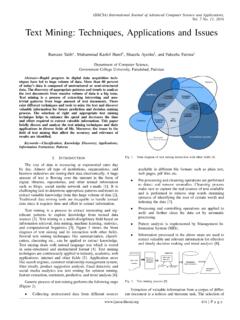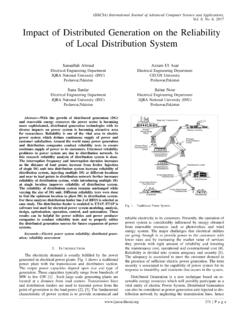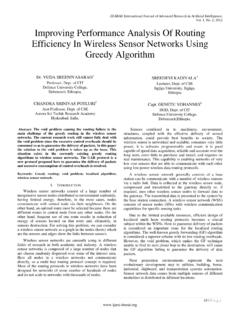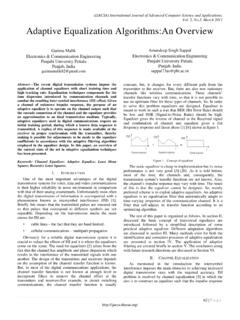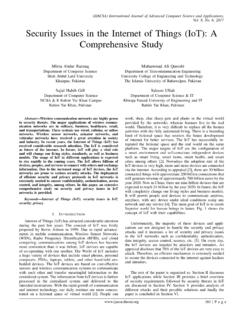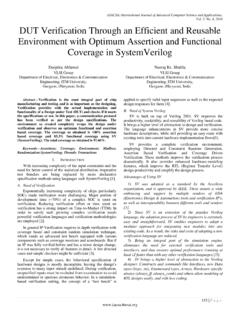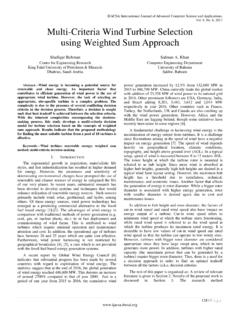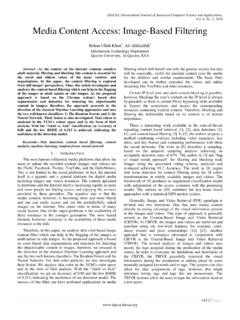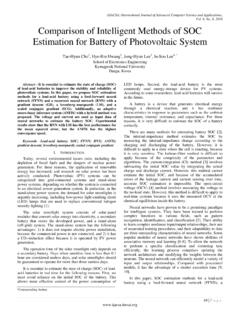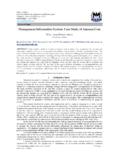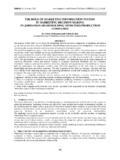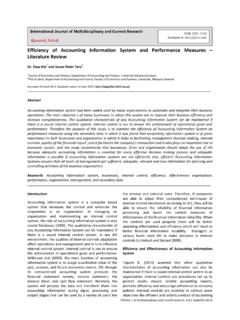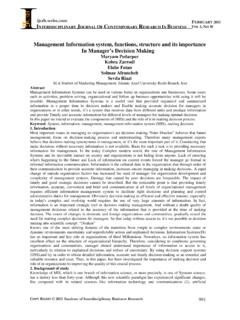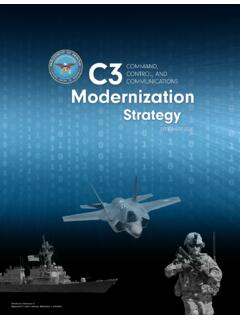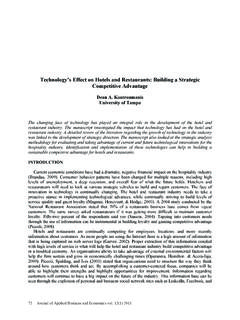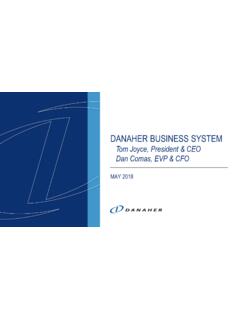Transcription of The Role of Strategic Information Systems (SIS) in ...
1 (IJACSA) International Journal of Advanced Computer Science and Applications, Vol. 8, No. 7, 2017 128 | P a g e The Role of Strategic Information Systems (SIS) in Supporting and Achieving the competitive Advantages (CA): An Empirical Study on Saudi Banking SectorNisreen F. Alshubaily Al Imam Mohammad Ibn Saud Islamic University (IMSIU) Riyadh, Saudi Arabia Abdullah A. Altameem Al Imam Mohammad Ibn Saud Islamic University (IMSIU) Riyadh, Saudi Arabia Abstract The purpose of this research paper is to identify the significant role of Strategic Information Systems (SIS) in supporting the competitive advantage (CA). It also explains its role on the dimensions that increase the competitive advantage which are the operational efficiency, Information quality and innovation. In order to achieve the goal of this study and to collect the primary data, the researchers designed a survey, in the form of an electronic questionnaire.
2 This survey instrument consisted of 20 questions. It was distributed to members of the study sample, which contains the managers at all levels, and the employees in the Saudi banking sector. The number of the participants included in the survey was 147. The results of this study revealed that there is a significant role of Strategic Information Systems on increasing operational efficiency, improving the quality of Information and promoting innovation. This in turn enabled the organizations to achieve higher levels of competitive advantages. The Strategic Information Systems have deep consequences for organizations that adopt them; managers could achieve great and sustainable competitive advantages from such Systems if carefully considered and developed.
3 On the other hand, this study was conducted in the banking sector in KSA context. So, more research is needed in other sectors and in the context of other countries; to confirm and generalize the results. Finally, the paper s primary value lies in its ability to provide the evidence that the Strategic Information Systems play a significant role in supporting and achieving the competitive advantages in Saudi Arabia, particularly in the banking sector. Since there was a lack of such research in the Saudi context, this paper can provide a theoretical basis for future researchers as well as practical implications for managers. Keywords Strategic Information Systems (SIS); competitive advantage (CA); operational efficiency; Information quality; innovation I. INTRODUCTION In the light of today s global economy, the organizations face several challenges such as globalization, privatization, stiff competition and more demanding customer expectations, coupled with daily advancement in Information and communication technologies.
4 In this environment, the top managers should understand and realize that the IS/IT is not merely a resource to support day-to-day operations. They should also realize that the clever use of IS/IT can significantly change an organization s long term Strategic position in national and global markets. Therefore, it becomes increasingly imperative that the managers create new and different strategies including the change of top management for long-term planning and Strategic decision-making versus the operational decision-making. Subsequently, if the organizations wish to remain successful and to be competitive , the managers need to consider Information Systems (ISs) as a tool utilized to gain competitive advantages, in order to overcome the other competitive organizations.
5 So, the Information Systems that help seize opportunities of gain competitive advantages are often called Strategic Information Systems (SIS). The Strategic Information system can be defined as an Information system that creates or enhances the company s competitive advantage or changes the industry structure by fundamentally changing how business is conducted. It is conventional Information Systems used in innovative ways [1]. In [2], [3], the authors confirm that it can be any kind of Information Systems (such as TPS, MIS, DSS, EIS, OAS, ERP, etc.) that helps an organization: 1) gain a competitive advantage ; 2) reduce a competitive disadvantage; and/or 3) meet other Strategic organization objectives. Hence, any IS has the ability to change the goals, processes, products, or environmental relationships to help an organization gain a competitive advantage or reduce a competitive disadvantage is a Strategic IS [1], [4].
6 In addition, the SIS involves using Information technology to develop products, services, and capabilities that give a company Strategic advantages over the competitive forces it faces in the global marketplace [2]. The advances in Information provision have led organizations to attempt to develop IS or IT strategies align with their business strategies to achieve many benefits [1]. Such as helping the organization to reduce overall costs, get fewer errors and greater accuracy when performing operations, produce high-quality products and services, accelerate communication and data sharing, improve performance and productivity, and make management more efficient and effective. Moreover, it gives the managers the ability to adjust, control and monitor all business processes which accordingly will accelerate the processes of the decision-making [3], [5]-[7].
7 (IJACSA) International Journal of Advanced Computer Science and Applications, Vol. 8, No. 7, 2017 129 | P a g e In this context, the purpose of this paper is to highlight the role of Strategic Information Systems (SIS) in supporting and achieving competitive advantage (CA); in order to obtain the higher level of operational efficiency, Information quality and innovation on the Saudi banking sector. II. LITERATURE REVIEW The concept of Strategic Information Systems (SIS) was introduced for the first time in the field of Information Systems in the early 1980s by Dr. Charles Wiseman [8]. The Strategic Information Systems have been established as a core activity in the governance and management of Information technology in organizations. Moreover, they have become a very challenging subject for scientists and practitioners in the recent years [9], [10].
8 Strategic Information Systems are essential to help organizations succeed in today s highly competitive global business environment. The organizations in the current IT age need to use Information Systems effectively which require an understanding of the organization, management, and Information technology that form the Systems [11]. It also requires an understanding that the mission of the Information Systems itself is changed and evolved from a focus on efficiency and effectiveness to a focus on organization performance as the foundation for competitiveness in a rapidly changing environment [12]. Therefore, the top managers should understand that the Information Systems alone cannot provide an enduring business advantage . In order to obtain the competitive advantage ; it is important to develop appropriate strategies that help to use the IS/IT based Systems effectively and provide means to manage them [11].
9 To achieve this goal, an increasing number of the organizations are turning to develop Information Systems Strategies (ISS) by applying one methodology or approach of Strategic Information Systems Planning (SISP) [13], which helps them to convert their conventional Information Systems to Strategic Information Systems (SIS). Strategic Information Systems are Systems that help organizations alter their business strategies, plans or structure. They are also used to hasten the reaction time of the environmental changes and aid the organization to achieve a competitive advantage over its competitors. Strategic Information Systems are the traditional or conventional Information Systems used in innovative ways [1]. The essential purpose of the Strategic Information Systems is to help organizations to do things better [14].
10 They also aim to develop and maintain the IS/IT Systems that support the business operations in an effective way [11]. They are as instrumental in achieving the organization s competitive objectives or other Strategic objectives [3]. They help an organization gain a competitive advantage through its contribution to achieve the Strategic goals and/or its ability to significantly increase the performance and productivity [4]. The main objective of SIS according to [1] is to define the explicit connection between an organization s business plans and IS plans to better achieve the goals and objectives and to provide closer management control for the critical IS/IT Systems . However, the successful use of Information Systems in order to achieve a competitive advantage is difficult.
